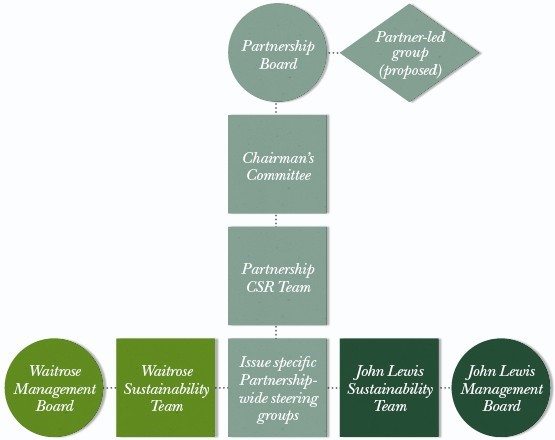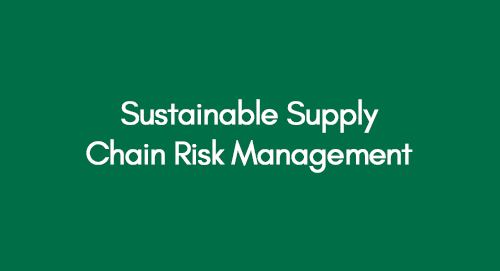
Exploring BIM in Design Coordination Along With Integrated Project Delivery
December 20, 2020
The Role of Relational Capital for Entrepreneurial Firms
December 20, 2020In today's increasingly complex and interconnected world, supply chain risk management has risen to paramount importance as a critical element of business success. Modern organizations must navigate a landscape where traditional supply chain risks coexist with various sustainability-related challenges. In this evolving scenario, sustainable supply chain risk management is a pivotal approach that ensures a company's resilience and long-term viability. In this blog, we will delve into the concept of sustainable supply chain risk management, emphasizing its significance in today's business environment.
Learn More About Risk Management
Explore More About Risk Management
Understanding the concept of sustainable supply chain risk management is the first step towards creating a robust strategy for your organization. The growing complexity of global supply chains has made it imperative to move beyond traditional risk assessment and mitigation. This paradigm shift necessitates companies to address the conventional issues associated with their supply chains and proactively manage sustainability risks. This two-fold approach is a cornerstone for securing your business's future. In the upcoming sections, we will explore the notion of sustainable supply chain risk management in depth, emphasizing its significance and delving into strategies for its effective implementation.
Company Background
The John Lewis Partnership (JLP) stands as a prominent player in the UK high street retail and department store chains, distinguished by its forward-thinking corporate values and operational excellence. The paramount objective of the business is the contentment of its employees, referred to as "partners" within the company. JLP boasts a network of 46 John Lewis Shops, supported by a dedicated workforce of approximately 89,000 permanent staff members or partners.
In addition to the JLP stores, the group also possesses 345 Waitrose supermarkets, a manufacturing facility, a catalogue business, and a sustainable farming centre (Harrington 2013). In 2014, the company achieved a significant milestone with annual sales crossing the £10 billion mark. Notably, the standout feature of the business lies in its profit-sharing arrangement with its permanent employees. JLP primarily operates in three sectors: home accessories, fashion products, and consumer electronics, with small-format shops and home shops serving as the preferred business format for these categories. The assortment of products available in the UK stores encompasses over 20,000 items, accessible both through physical outlets and online channels (JLP website n.d.).
Organizational Structure
JLP's business model is grounded in a democratic organizational framework where employees actively participate in profit-sharing and assume shared responsibilities (Cooke 2014). The company's divisional structure revolves around the central tenets of John Lewis Partnership governance boards, which are dedicated to upholding rigorous standards and fostering competitive policies.
The Divisional Management Board (DMB) plays a pivotal role in overseeing the day-to-day operations of the stores and adheres to the guidance provided by the chairman and the Divisional Council. Additionally, the Branch Forum operates at the store level, with executives selected from JLP's partners, who work collaboratively to address various operational matters. The organizational structure of the sustainability division of JLP can be shown below.

Figure 1: Organizational Structure of JLP Source: JLP website
Critical Analysis of the Sustainable Supply Chain and Logistics Operations
Products of JLP
At JLP, three distinct categories of product lines encompass home, fashion, and electronics items catering to the UK's consumer markets, available through the format and home shops. The online retailing of these products commenced in 2009 with the introduction of the "Click & Collect" service, solidifying the store chain's status as one of the UK's foremost retail chains.
Renowned for its omnichannel approach, JLP's service allows customers to place orders and subsequently retrieve them from any convenient JLP store or Waitrose supermarket (Khan et al. 2008). While this convenience in product selection and collection has driven online sales growth, it has simultaneously presented challenges in managing separate distribution centres for both physical and online retail channels (Hall 2013). Consequently, the order fulfilment process, tailored to individual customer preferences, has become complex for the company due to the involvement of multiple channels and delivery destinations.
SCM Performance Imperatives
Hall (2013) asserted that JLP has invested heavily in ERP solutions, distribution networks, and complete overhauling of the order management system (OMS) to support the front and back-end supply chain activities and enhance multichannel expertise. The new OMS is meant to upgrade the company infrastructure and the involved business operations. These OMS include in-store orders linked with web orders and also with the EPOs terminals to improve the goods return handling and multiple transactions of currency in global sales (Pilkington and Meredith 2009). According to Burton (2013), a unified stock management system supports the order tracking and delivery procedures for in-store and online sales. Another important element in supply management is the operation of click-and-collect service. Through this enhanced OMS, the customers can book their orders till 7 p.m. and collect them by 2 p.m. the next day.
The management information systems (MIS) also played an important role in sustainable SCM at JLP and supported the complete transactions systems at the company (Kremic et al. 2006). Activities like stock checking, reporting, and retailing are performed in branches through a consolidated MIS that supports managers in deciding about the shop locations and categorization of products in specific stores (Caldwell, 2009). The highly developed management systems also allow the company to attain real-time information on various parameters, inducing inventory updates, budget utilization reports, sales updates, manufacturing data, and human resource management. Implications of such computer-aided systems help the practitioners associated with the company to manage their scope of work in shorter time intervals and with more precision. Hence, these systems are important in managing SCM activities at JLP to decrease expenditures on monitoring and replacing stocks and the competitive price differences with competitors.
Evaluation of Sustainable SCM at JLP
Sustainable Sourcing
Sustainable sourcing practices determined the standards of selection of products and raw materials from trusted suppliers globally. According to Lu et al. (2011), selecting sustainable sources is important to establish a socially responsible supply chain activity. Sustainable sourcing has been much emphasized in recent years primarily due to the recent focus of the global communities to sustain the environment through every possible methodology.
The main issues in establishing a sustainable supply chain at JLP are the globalization of procurement activities, changing environmental conditions and global warming, and the availability of quality natural resources in a cost-effective mode of supply, which can create major risks to SCM. The company made efforts to increase the traceability of their procured products to ensure their quality and sustainable features are incorporated (JLP Sustainability Report 2014).
The major issues related to sustainable sourcing at JLP are assurance of employee's rights, avoidance of deforestation activities, especially rain forests of Amazon and in equatorial climate, sustainable fishing and agriculture, and purchase of British manufactured goods are some means through which the company can sustain its image a CSR oriented organization, use of sustainable manufacturing sources in their products. As Tang (2006) asserted, the integrity and quality of the supply chain activities help the company establish a sustainable image.
Some important sustainable sourcing activities at JLP are outlined in the table below:
Table 1: sustainable sourcing activities
| Products/ service | Sustainable sourcing | Impact on SCM at JLP |
Raw materials Fishery | Responsible sourcing of fish and shellfish at Waitrose | · Regular audits to ensure the supply of allowed types of fish only (400 audits in 2014) (JLP 2014). · Third-party certification is used in nearly 78% of Waitrose products. · ‘Best Fish Counter’ award for Waitrose in 2014. |
Agriculture | Sustainable sourcing of soy, cotton, and palm oil, import of RTRS Certified soya and Pro Terra Certified soya | Complete sustainable varieties of soy and corn will be achieved by the end of 2015/16, with a ‘Soya Scorecard’ commendation by WWF in 2014. Waitrose uses 100% CSPO in its stores. JLP joined the Better Cotton Initiative (BCI) program to support better living conditions for cotton growers in developing countries like Egypt, India, and other Asian and African countries. Membership of |
| Deforestation and loss of habitat | British Retail Consortium (BRC) and Timber Working Group members to assure ethical trading and to avoid illegal deforestation activities in 2014. |
Ethical Trading
Ethical trading through strong and long-term supplier relationships has supported JLP's continual enhancements in sustainable SCM practices. In 2011, the company joined the Ethical Trading Initiative (ETI) to improve the international workforce operating conditions through alliances with global suppliers, unions, and NGOs. The main purpose of ETI is to focus on global workers to provide satisfactory and healthy conditions to grow or make the products. For instance, in the year 2014, Waitrose has taken the initiative with the Association of Labour Providers (ALP), GLA, and Charity Migrant NGO to recognize exploitation in fisheries and agriculture. This initiative involves the engagement of 1,000 plus farms, labour and food producers that contain more than 100K workers globally.
Risk Management and Uncertainties in SCM
According to Goh et al. (2007), sustainable supply chains face risk management issues that need a holistic approach to develop the expertise to minimize risks to all functional areas of the enterprise. Also, Peck (2006) declared that risk management in supply change has three significant elements: preventing disruptions, controlling non-preventable events, and mitigating risky events in the company.
Some of the important supply chain risks faced by JLP and stated in the annual sustainability report (2104) are discussed below:
Long-Term Relationship With Suppliers
Given the large business size of JLP, controlling thousands of global suppliers and monitoring their activities is a cause of risk to the company (Wang & Huang 2010). The uncertainty in the global working environment, climatic change, and law and order situations can disturb the suppliers’ delivery and order management efficiency. Therefore, incorporating suppliers in every long-term change in the company is very important. The materialization process at JLP is an example of involving all company stakeholders, including suppliers (Annual Report 2014).
Price Competition Aggressiveness
The aggressive price competition in the UK retail market greatly affects the profit margin and profitability. Waitrose customers’ survey in 2014 showed a greater emphasis on value for money rather than store brand loyalty (Cooke 2014). Also, government taxations like VAT, high unemployment, and spending limitation of customers limit the price margin for suppliers; therefore, a risk of tradeoff on quality is generated (Tapiero 2007).
A strain of the Operating Model
The company's operations depend highly on changes in customer preferences; online market challenges, which propose a considerable risk and need for updated IT infrastructure, put pressure on JLP performance and force the partners to work in challenging conditions. The operational potential of the firm also gets disturbed due to the inability to fulfil customers’ demands.
Mitigation and Management of Supply Chain Risks
To manage the discussed risks, JLP has initiated important mitigation tasks as follows:
- Huge investment in enhancing IT infrastructure and supply chain capabilities through adaptation of omnichannel distribution facilities.
- Considered partners as a central point of all major developments in sustainable SCM.
- Continual introduction of new products and high-quality standards governed by the boards established at JLP.
- Allocation of lucrative sales and management practices to fulfil customers’ requirements at their convenience through advanced MIS and OMS facilities.
- The operating procedures are revised and upgraded to increase the efficiency of SCM. Project management capabilities are developed, and the board is changed to monitor the supply chain effectively.
Conclusion
In conclusion, the John Lewis Partnership is found to have a competent and advanced sustainable supply chain operation but has faced risks of suppliers, customer handling, and operation management from time to time. Apart from heavy investment in infrastructure and facilities development, the company needs a balanced approach to achieve a sustainable and socially responsible supply chain without compromising profit margins. Properly fulfilling committed standards and sustainable resourcing, farming, and procurement is important, along with the transparent reporting of these actions.
References
Burton, G (2013) John Lewis passes £1bn web sales as it implements new web platform. Computing. [Online] 23 April. Available from:http://www.computing.co.uk/ctg/news/2263491/john-lewis-passes-gbp1bn-web-sales-as-it-implements-new-web-platform.[Accessed: 25th November 2015].
Caldwell, T. (2009)John Lewis IT head ditched critical data project to fight the recession. CIO. [Online] 12th October. Available from http://www.cio.co.uk/insight/change-management/john-lewis-it-head-ditched-critical-data-project-to-fight-recession/. [Accessed: 21st November 2015].
Cisco (2012). Leading U.K. Retailer John Lewis, Changes the Face of Retail Operations Through Innovative Use of Video-Based Technology in Shops. [pdf] Available from:http://www.cisco.com/web/about/ac79/docs/retail/John-Lewis-at-home.pdf. [Accessed: 25th November 2015].
Cooke, J., (2014), A supply chain redesign for omnichannel success, Supply Chain | From the Quarter 2 2014 issue, accessed on 25th November 2015
Goh, M., Lim, J.Y.S., Meng, F., 2007. A stochastic model for risk management in global supply chain networks. EuropeanSodhi, M.S., Son, B., Tang, C.S., 2012. Researchers’ perspectives on supply chain risk management. Production and Operations Management 21 (1), 1-13.
Hall, K (2013). Online success wedded to in-store IT, says John Lewis. Computer weekly news.[Online] 30th January. Available from:http://www.computerweekly.com/news/2240177215/Online-success-wedded-to-in-store-IT-says-John-Lewis. [Accessed: 25th November 2015]
Harrington, J (2013). John Lewis in shock decision to cull management. Proactive investors. [Online]. 14th February. Available from: http://www.proactiveinvestors.co.uk/companies/news/53693/john-lewis-in-shock-decision-to-cull-management-53693.html [Accessed: 25th November 2015].
John Lewis Partnership (n.d.). John Lewis. [Online]. Available from:http://www.johnlewispartnership.co.uk/about/john-lewis.html. [Accessed: 25th November 2015].
John Lewis Partnership (n.d.). Management Bodies [Online]. Available from:http://www.johnlewispartnership.co.uk/about/the-partnership/management-bodies.html. [Accessed: 20th November 2013].
Kremic, T., Tukel, O.I., Rom, W.O., 2006. Outsourcing decision support: a survey of benefits, risks, and decision factors. Supply Chain Management: An International Journal 11 (6), 467–482.
Khan, O., Christopher, M., Burnes, B., 2008. The impact of product design on supply chain risk: a case study. International Journal of Physical Distribution and Logistics Management 38 (5), 412-432.
Lu, M., Huang, S., Shen, Z.M., 2011. Product substitution and dual sourcing under random supply failures. Transportation Research Part B 45, 1251–1265.
Pilkington, A., Meredith, J., 2009. The evolution of the intellectual structure of operations management--1980-2006: A citation/co-citation analysis. Journal of Operations Management 27, 185-202.
Peck, H., 2006. Reconciling supply chain vulnerability, risk and supply chain management. International Journal of Logistics: Research and Application, Vol. 9, No. (2), June 2006, 127-142.
Tapiero, C.S., 2007. Consumer risk and quality control in a collaborative supply chain. European Journal of Operational Research 182, 683–694
Tang, C.S., 2006. Perspectives in supply chain risk management. International Journal of Production Economics 103, 451–488.
Wang, X.Y., Huang, X.B., 2010. Supply chain bullwhip effect simulation under different inventory strategies. Logistics and Supply Chain Research in China, 27-34.
Get 3+ Free Dissertation Topics within 24 hours?



























